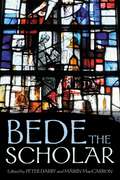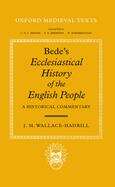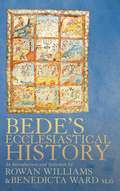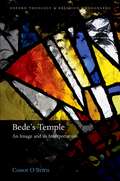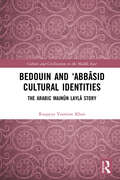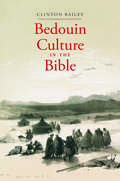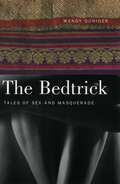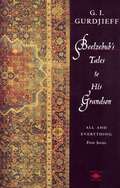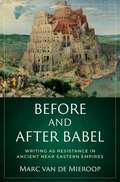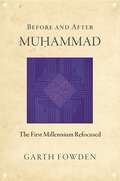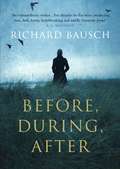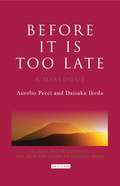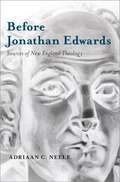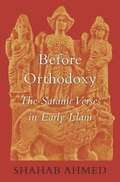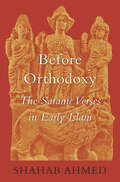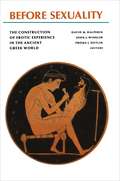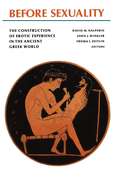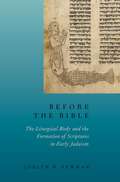- Table View
- List View
Bede the scholar
by Peter Darby Máirín MacCarronDistilling a decade of research by leading experts on the Venerable Bede, Bede the scholar investigates the Northumbrian monk’s place within the wider intellectual developments of the early medieval world. Demonstrating the centrality of the Bible to his scholarship, chapters focus on Bede’s engagement with scriptural languages, his knowledge and use of earlier works of Latin literature, and a pastoral commitment to teaching and preaching. The book breaks new ground for our understanding of Bede’s self image by investigating his famous Ecclesiastical history of the English people alongside lesser-known works such as the Martyrology, the commentary On Genesis, and the chapter headings he developed for different parts of the Vulgate Bible. Contributors highlight the importance of appreciating Bede’s work within its local setting: the kingdom of Northumbria and the monastery of Wearmouth, whose founders, Benedict Biscop and Ceolfrith, inspired Bede in various ways. The monastery provided an environment in which Bede could flourish, and where he contributed to an intellectual enterprise which also generated the Codex Amiatinus, the earliest one-volume Vulgate to survive fully intact.Combining rigorous scholarly research with a celebration of the depth and complexity of Bede’s work, Bede the scholar deepens our understanding of the scholarly programme undertaken by one of the most important intellectual figures of the early middle ages.
Bede the scholar
by Peter Darby and Máirín MacCarronDistilling a decade of research by leading experts on the Venerable Bede, Bede the scholar investigates the Northumbrian monk’s place within the wider intellectual developments of the early medieval world. Demonstrating the centrality of the Bible to his scholarship, chapters focus on Bede’s engagement with scriptural languages, his knowledge and use of earlier works of Latin literature, and a pastoral commitment to teaching and preaching. The book breaks new ground for our understanding of Bede’s self image by investigating his famous Ecclesiastical history of the English people alongside lesser-known works such as the Martyrology, the commentary On Genesis, and the chapter headings he developed for different parts of the Vulgate Bible. Contributors highlight the importance of appreciating Bede’s work within its local setting: the kingdom of Northumbria and the monastery of Wearmouth, whose founders, Benedict Biscop and Ceolfrith, inspired Bede in various ways. The monastery provided an environment in which Bede could flourish, and where he contributed to an intellectual enterprise which also generated the Codex Amiatinus, the earliest one-volume Vulgate to survive fully intact.Combining rigorous scholarly research with a celebration of the depth and complexity of Bede’s work, Bede the scholar deepens our understanding of the scholarly programme undertaken by one of the most important intellectual figures of the early middle ages.
Bede's Ecclesiastical History Of The English People: A Historical Commentary (Oxford Medieval Texts)
by J. M. Wallace-HadrillBede's Ecclesiastical History of the English People is recognized as a masterpiece among the historical literature of medieval England and Europe. Completed in 731, it comprises in a single flowing narrative a coherent history of the conversion of the English peoples to Christianity, and thestory of the island kingdoms and churches from the 590s to the early eighth century, prefaced by a sketch of the earlier history of Britain. In 1969 the Clarendon Press published the new edition in Oxford Medieval Texts, edited by Bertram Colgrave and Sir Roger Mynors. Mynors's masterly text and textual introduction replaced much of Charles Plummer's great edition of 1896; but the historical notes did not attempt to match in scale anddetail Plummer's second volume of commentary. To fill this gap the late Professor J. M. Wallace-Hadrill devoted the last years of his life to a new commentary, one of the finest and most mature fruits of his scholarship - more succinct than Plummer, tauter, more relevant, above all drawing togetherand adding to the findings of a galaxy of modern scholars. Prepared for the press by Thomas Charles-Edwards, helped by Patrick Wormald and others, this book completes the new Bede, and is prefaced by a paper characteristic of Professor Wallace-Hadrill on 'Bede and Plummer'.
Bede's Ecclesiastical History of the English People: An Introduction and Selection
by Benedicta Ward Rowan WilliamsBede's best known work, An Ecclesiastical History of the English People, was written in Latin and is not immediately easy to understand and follow. Yet it is a key text for any student of English history. Rowan Williams shows in his introduction how Bede works to create a sense of national destiny for the new English kingdoms of the seventh century, a sense that has helped to shape English self-awareness through the centuries, by using the imagery both of imperial Rome and of biblical Israel. But Bede also wrestles with the difficult question of how the Church relates to and serves the political order. The attraction and fascination of his work is partly in seeing the tension between the strategic use of wealth and political power for religious ends and the example of self-effacing service and simplicity of life offered by some of Bede's greatest Christian heroes. The issues around these questions are not academic or antiquarian. Understanding Bede is a key to understanding British society in the present as well as the past.
Bede's Ecclesiastical History of the English People: An Introduction and Selection
by Rowan Williams Benedicta WardBede's best known work, An Ecclesiastical History of the English People, was written in Latin and is not immediately easy to understand and follow. Yet it is a key text for any student of English history. Rowan Williams shows in his introduction how Bede works to create a sense of national destiny for the new English kingdoms of the seventh century, a sense that has helped to shape English self-awareness through the centuries, by using the imagery both of imperial Rome and of biblical Israel. But Bede also wrestles with the difficult question of how the Church relates to and serves the political order. The attraction and fascination of his work is partly in seeing the tension between the strategic use of wealth and political power for religious ends and the example of self-effacing service and simplicity of life offered by some of Bede's greatest Christian heroes. The issues around these questions are not academic or antiquarian. Understanding Bede is a key to understanding British society in the present as well as the past.
Bede's Temple: An Image and its Interpretation (Oxford Theology and Religion Monographs)
by Conor O'BrienThis volume examines the use of the image of the Jewish temple in the writings of the Anglo-Saxon theologian and historian, Bede (d. 735). The various Jewish holy sites described in the Bible possessed multiple different meanings for Bede and therefore this imagery provides an excellent window into his thought. Bede's Temple: An Image and its Interpretation examines Bede's use of the temple to reveal his ideas of history, the universe, Christ, the Church, and the individual Christian. Across his wide body of writings Bede presented an image of unity, whether that be the unity of Jew and gentile in the universal Church, or the unity of human and divine in the incarnate Christ, and the temple-image provided a means of understanding and celebrating that unity. Conor O'Brien argues that Bede's understanding of the temple was part of the shared spirituality and communal discourse of his monastery at Wearmouth-Jarrow, in particular as revealed in the great illuminated Bible made there: the Codex Amiatinus. Studying the temple in Bede's works reveals not just an individual genius, but a monastic community engaged actively in scriptural interpretation and religious reflection. O'Brien makes an important contribution to our understanding of early Anglo-Saxon England's most important author, the world in which he lived, and the processes that inspired his work.
Bedouin and ‘Abbāsid Cultural Identities: The Arabic Majnūn Laylā Story (Culture and Civilization in the Middle East)
by Ruqayya Yasmine KhanThis literary-historical book draws out and sheds light upon the mechanisms of "the ideological work" that the Arabic Majnūn Laylā story performed for ‘Abbāsid urbanite, imperial audiences in the wake of the disappearance of the "Bedouin cosmos." The study focuses upon the processes of primitivizing Majnūn in the romance of Majnūn Laylā as part of the paradigm shift that occurred in the ‘Abbāsid empire after the Greco-Arabian intellectual revolution. Moreover, this book demonstrates how gender and sexuality are employed in the processes of primitivizing Majnūn. As markers of "strangeness" and "foreignness" in the ‘Abbāsid interrogations of the multiple categories of ethnicity, culture, identity, religion and language present in their cosmopolitan milieus. Such "cultural work" is performed through the ideological uses of alterity given its mechanisms of distancing (e.g., temporal and spatial) and nearness (e.g., affective). Lastly, the Majnūn Laylā love story demonstrates, in its text and reception, that a Greco-Arabian and Greco-Persian subculture thrived in the centers of ‘Abbāsid Baghdad that molded and shaped the ways in which this love story was compiled, received and performed. Offering a corrective to the prevailing views expressed in Western scholarly writings on the Greco-Arabian encounter, this book is a major contribution to scholars and students interested in Islamic studies, Arabic and comparative literature, Middle East and gender studies.
Bedouin and ‘Abbāsid Cultural Identities: The Arabic Majnūn Laylā Story (Culture and Civilization in the Middle East)
by Ruqayya Yasmine KhanThis literary-historical book draws out and sheds light upon the mechanisms of "the ideological work" that the Arabic Majnūn Laylā story performed for ‘Abbāsid urbanite, imperial audiences in the wake of the disappearance of the "Bedouin cosmos." The study focuses upon the processes of primitivizing Majnūn in the romance of Majnūn Laylā as part of the paradigm shift that occurred in the ‘Abbāsid empire after the Greco-Arabian intellectual revolution. Moreover, this book demonstrates how gender and sexuality are employed in the processes of primitivizing Majnūn. As markers of "strangeness" and "foreignness" in the ‘Abbāsid interrogations of the multiple categories of ethnicity, culture, identity, religion and language present in their cosmopolitan milieus. Such "cultural work" is performed through the ideological uses of alterity given its mechanisms of distancing (e.g., temporal and spatial) and nearness (e.g., affective). Lastly, the Majnūn Laylā love story demonstrates, in its text and reception, that a Greco-Arabian and Greco-Persian subculture thrived in the centers of ‘Abbāsid Baghdad that molded and shaped the ways in which this love story was compiled, received and performed. Offering a corrective to the prevailing views expressed in Western scholarly writings on the Greco-Arabian encounter, this book is a major contribution to scholars and students interested in Islamic studies, Arabic and comparative literature, Middle East and gender studies.
Bedouin Culture in the Bible
by Clinton BaileyThe first contemporary analysis of Bedouin and biblical cultures sheds new light on biblical laws, practices, and Bedouin history Written by one of the world’s leading scholars of Bedouin culture, this groundbreaking book sheds new light on significant points of convergence between Bedouin and early Israelite cultures, as manifested in the Hebrew Bible. Bailey compares Bedouin and biblical sources, identifying overlaps in economic activity, material culture, social values, social organization, laws, religious practices, and oral traditions. He examines the question of whether some early Israelites were indeed nomads as the Bible presents them, offering a new angle on the controversy over the identity of the early Israelites and a new cultural perspective to scholars of the Bible and the Bedouin alike.
The Bedtrick: Tales of Sex and Masquerade (Worlds of Desire: The Chicago Series on Sexuality, Gender, and Culture)
by Wendy Doniger"Somehow I woke up one day and found myself in bed with a stranger." Meant literally or figuratively, this statement describes one of the best-known plots in world mythology and popular storytelling. In a tour that runs from Shakespeare to Hollywood and from Abraham Lincoln to Casanova, the erudite and irrepressible Wendy Doniger shows us the variety, danger, and allure of the "bedtrick," or what it means to wake up with a stranger. The Bedtrick brings together hundreds of stories from all over the world, from the earliest recorded Hindu and Hebrew texts to the latest item in the Weekly World News, to show the hilariously convoluted sexual scrapes that people manage to get themselves into and out of. Here you will find wives who accidentally commit adultery with their own husbands. You will read Lincoln's truly terrible poem about a bedtrick. You will learn that in Hong Kong the film The Crying Game was retitled Oh No! My Girlfriend Has a Penis. And that President Clinton was not the first man to be identified by an idiosyncratic organ. At the bottom of these wonderful stories, ancient myths, and historical anecdotes lie the dynamics of sex and gender, power and identity. Why can't people tell the difference in the dark? Can love always tell the difference between one lover and another? And what kind of truth does sex tell? Funny, sexy, and engaging, The Bedtrick is a masterful work of energetic storytelling and dazzling scholarship. Give it to your spouse and your lover.
Beelzebub's Tales to His Grandson: All and Everything (All And Everything First Ser.)
by G. GurdjieffBEELZEBUB'S TALES TO HIS GRANDSON is Gurdjieff's world-famous cosmological epic. It examines human life on Earth from the viewpoint of beings belonging to a distant world, led by the 'all-wise Beelzebub'. Through this cosmological allegory - rich in humour, anecdote and linguistic elaboration - Gurdjieff demonstrates a methodology for the spiritual growth of all mankind.
Before and after Babel: Writing as Resistance in Ancient Near Eastern Empires
by Marc Van De Mieroop"The Lord confused the language of all the earth," so the Tower of Babel story in the Hebrew Bible's book of Genesis tells us to explain why the world's people communicate in countless languages while previously they all spoke only one. This book argues that the biblical confusion really happened in the ancient Near East, not in speech, however, but in writing. It examines the millennia-long history of writing in the region and shows a radical change from the third and second millennia to the first millennium BC. Before "Babel" any intellectual who wrote did so as a participant in a cosmopolitan tradition with its roots in Babylonia, its language, and its cuneiform script. After "Babel" scribes from all over the eastern Mediterranean, including Greece, used a profusion of vernacular languages and scripts to express themselves. Yet they did so in dialogue with the Babylonian cuneiform tradition still maintained by the successive Assyrian, Babylonian, and Persian empires that controlled their world, oftentimes as acts of resistance, aware of cosmopolitan ideas and motifs but subverting them. In order to frame the rich intellectual history of this region in the ancient past Before and after Babel describes and analyzes the Babylonian cosmopolitan system, how ancient Greek, Hebrew, Aramaic, and other vernacular systems interacted with it in multiple and intricate ways, and their consequences.
Before and after Babel: Writing as Resistance in Ancient Near Eastern Empires
by Marc Van De Mieroop"The Lord confused the language of all the earth," so the Tower of Babel story in the Hebrew Bible's book of Genesis tells us to explain why the world's people communicate in countless languages while previously they all spoke only one. This book argues that the biblical confusion really happened in the ancient Near East, not in speech, however, but in writing. It examines the millennia-long history of writing in the region and shows a radical change from the third and second millennia to the first millennium BC. Before "Babel" any intellectual who wrote did so as a participant in a cosmopolitan tradition with its roots in Babylonia, its language, and its cuneiform script. After "Babel" scribes from all over the eastern Mediterranean, including Greece, used a profusion of vernacular languages and scripts to express themselves. Yet they did so in dialogue with the Babylonian cuneiform tradition still maintained by the successive Assyrian, Babylonian, and Persian empires that controlled their world, oftentimes as acts of resistance, aware of cosmopolitan ideas and motifs but subverting them. In order to frame the rich intellectual history of this region in the ancient past Before and after Babel describes and analyzes the Babylonian cosmopolitan system, how ancient Greek, Hebrew, Aramaic, and other vernacular systems interacted with it in multiple and intricate ways, and their consequences.
Before and After Muhammad: The First Millennium Refocused
by Garth FowdenIslam emerged amid flourishing Christian and Jewish cultures, yet students of Antiquity and the Middle Ages mostly ignore it. Despite intensive study of late Antiquity over the last fifty years, even generous definitions of this period have reached only the eighth century, whereas Islam did not mature sufficiently to compare with Christianity or rabbinic Judaism until the tenth century. Before and After Muhammad suggests a new way of thinking about the historical relationship between the scriptural monotheisms, integrating Islam into European and West Asian history.Garth Fowden identifies the whole of the First Millennium--from Augustus and Christ to the formation of a recognizably Islamic worldview by the time of the philosopher Avicenna--as the proper chronological unit of analysis for understanding the emergence and maturation of the three monotheistic faiths across Eurasia. Fowden proposes not just a chronological expansion of late Antiquity but also an eastward shift in the geographical frame to embrace Iran.In Before and After Muhammad, Fowden looks at Judaism, Christianity, and Islam alongside other important developments in Greek philosophy and Roman law, to reveal how the First Millennium was bound together by diverse exegetical traditions that nurtured communities and often stimulated each other.
Before and After Muhammad: The First Millennium Refocused (PDF)
by Garth FowdenIslam emerged amid flourishing Christian and Jewish cultures, yet students of Antiquity and the Middle Ages mostly ignore it. Despite intensive study of late Antiquity over the last fifty years, even generous definitions of this period have reached only the eighth century, whereas Islam did not mature sufficiently to compare with Christianity or rabbinic Judaism until the tenth century. Before and After Muhammad suggests a new way of thinking about the historical relationship between the scriptural monotheisms, integrating Islam into European and West Asian history.Garth Fowden identifies the whole of the First Millennium--from Augustus and Christ to the formation of a recognizably Islamic worldview by the time of the philosopher Avicenna--as the proper chronological unit of analysis for understanding the emergence and maturation of the three monotheistic faiths across Eurasia. Fowden proposes not just a chronological expansion of late Antiquity but also an eastward shift in the geographical frame to embrace Iran.In Before and After Muhammad, Fowden looks at Judaism, Christianity, and Islam alongside other important developments in Greek philosophy and Roman law, to reveal how the First Millennium was bound together by diverse exegetical traditions that nurtured communities and often stimulated each other.
Before, During, After (Vintage Contemporaries Ser.)
by Richard BauschNatasha, a lonely congressional aide, meets Michael Faulk, a priest struggling with his faith. Love blossoms over the spring and summer of 2001. A month before their wedding, Natasha is on a trip in Jamaica and Michael is in New York when the World Trade Center is attacked. That same day, Natasha endures a private trauma of her own: she is raped by a young man on the shores of the Caribbean. She and Michael are soon reunited, but the horror of that day, and Natasha's inability to speak of it, means that there will forever be a sharp line that divides their relationship into before and after.
Before it is Too Late: A Dialogue (Echoes and Reflections)
by Aurelio Pecci Daisaku IkedaLong before it became fashionable to talk of climate change, drought and water shortages, the authors of this lucid and trenchant dialogue were warning that planet earth was heading for uninhabitability. Exchanging viewpoints and insights that have matured over many years of thought, study and reflection, the discussants address a number of critical questions under three broad headings: man and nature, man and man, and the human revolution. One of the authors is a Westerner - a man of many parts, both wartime resistance fighter and leading industrialist, who founded one of the first organisations and think tanks to address seriously the human prospects for global survival. The other represents the philosophical and ethical perspectives of the East - a Buddhist lay leader who has visited country after country, campaigning tirelessly for the abolition of nuclear weapons and war in all its forms. Engaging constructively and imaginatively with such seemingly intractable problems as population growth, the decline of natural resources, desertification, pollution and deforestation, Ikeda and Peccei show that many of these problems are interrelated. Only be addressing them as part of a web of complex but combined issues, and by working together for peace and justice, can human beings expect to find lasting solutions. So while recognising the scale of the challenge ahead, the authors' message is in the end a hopeful one. Man's best prospect for the future lies in an ethical revolution whereby humanity can find a fresh understanding of itself in holistic connection with, rather than separation and alienation from, the planet itself.
Before Jonathan Edwards: Sources of New England Theology
by Adriaan C. NeeleIn Before Jonathan Edwards, Adriaan Neele seeks to balance the recent academic attention to the developments of intellectual history after Jonathan Edwards. Neele presents the first comprehensive study of Edwards's use of Reformed orthodox and Protestant scholastic primary sources in the context of the challenges of orthodoxy in his day. Despite the breadth of Edwards scholarship, his use of primary sources has been little analyzed. Yet, as Neele proves, Edwards's thinking on the importance of these primary sources has significant implications not only for the status of the New England theology of pre-Revolutionary America but also for our understanding of Edwards today. This volume locates Edwards's ideas in the context of the theological and philosophical currents of his day, as well as in the pre-modern exchange of books and information during the colonial period. The pre-Revolutionary status of theology and philosophy in the wake of the Enlightenment had many of the same problems we see in our theological education today with respect to the use and appropriation of classical theology in a 21st-century context. Ideas about the necessity of classical primary sources of Christianity in sustaining our theological education are once again becoming important, and Edwards offers many relevant insights. Edwards was not unique in his deployment of these primary sources; many New England pastors, including Cotton Mather (1663-1728), preached and wrote about the necessity of orthodox theology. Edwards's distinction came in his thinking about the issues set forth in these sources at a transitional moment in the history of Christian thought.
Before Jonathan Edwards: Sources of New England Theology
by Adriaan C. NeeleIn Before Jonathan Edwards, Adriaan Neele seeks to balance the recent academic attention to the developments of intellectual history after Jonathan Edwards. Neele presents the first comprehensive study of Edwards's use of Reformed orthodox and Protestant scholastic primary sources in the context of the challenges of orthodoxy in his day. Despite the breadth of Edwards scholarship, his use of primary sources has been little analyzed. Yet, as Neele proves, Edwards's thinking on the importance of these primary sources has significant implications not only for the status of the New England theology of pre-Revolutionary America but also for our understanding of Edwards today. This volume locates Edwards's ideas in the context of the theological and philosophical currents of his day, as well as in the pre-modern exchange of books and information during the colonial period. The pre-Revolutionary status of theology and philosophy in the wake of the Enlightenment had many of the same problems we see in our theological education today with respect to the use and appropriation of classical theology in a 21st-century context. Ideas about the necessity of classical primary sources of Christianity in sustaining our theological education are once again becoming important, and Edwards offers many relevant insights. Edwards was not unique in his deployment of these primary sources; many New England pastors, including Cotton Mather (1663-1728), preached and wrote about the necessity of orthodox theology. Edwards's distinction came in his thinking about the issues set forth in these sources at a transitional moment in the history of Christian thought.
Before Orthodoxy: The Satanic Verses in Early Islam
by Shahab AhmedA controversial episode in the life of the Prophet Muhammad concerns an incident in which he allegedly mistook words suggested by Satan as divine revelation. Muslims now universally deny that the Satanic verses incident took place. But Muslims did not always hold this view. Shahab Ahmed uses this case to explore how religions establish truth.
Before Orthodoxy: The Satanic Verses in Early Islam
by Shahab AhmedA controversial episode in the life of the Prophet Muhammad concerns an incident in which he allegedly mistook words suggested by Satan as divine revelation. Muslims now universally deny that the Satanic verses incident took place. But Muslims did not always hold this view. Shahab Ahmed uses this case to explore how religions establish truth.
Before Sexuality: The Construction of Erotic Experience in the Ancient Greek World
by David M. Halperin Froma I. Zeitlin John J. WinklerA dream in which a man has sex with his mother may promise him political or commercial success--according to dream interpreters of late antiquity, who, unlike modern Western analysts, would not necessarily have drawn conclusions from the dream about the dreamer's sexual psychology. Evidence of such shifts in perspective is leading scholars to reconsider in a variety of creative ways the history of sexuality. In these fifteen original essays, eminent cultural historians and classicists not only discuss sex, but demonstrate how norms, practices, and even the very definitions of what counts as sexual activity have varied significantly over time. Ancient Greece offers abundant evidence for a radically different set of sexual standards and behaviors from ours. Sex in ancient Hellenic culture assumed a variety of social and political meanings, whereas the modern development of a sex-centered model of personality now leads us to view sex as the key to understanding the individual. Drawing on both the Anglo-American tradition of cultural anthropology and the French tradition of les sciences humaines, these essays explore the iconography, politics, ethics, poetry, and medical practices that made sex in ancient Greece not a paradise of liberation but an exotic locale hardly recognizable to visitors from the modern world. In addition to the editors, the contributors to this volume are Peter Brown, Anne Carson, Franoise Frontisi-Ducroux, Maud W. Gleason, Ann Ellis Hanson, Franois Lissarrague, Nicole Loraux, Maurice Olender, S.R.F. Price, James Redfield, Giulia Sissa, and Jean-Pierre Vernant.
Before Sexuality: The Construction of Erotic Experience in the Ancient Greek World (PDF)
by Froma I. Zeitlin John J. Winkler David M. HalperinA dream in which a man has sex with his mother may promise him political or commercial success--according to dream interpreters of late antiquity, who, unlike modern Western analysts, would not necessarily have drawn conclusions from the dream about the dreamer's sexual psychology. Evidence of such shifts in perspective is leading scholars to reconsider in a variety of creative ways the history of sexuality. In these fifteen original essays, eminent cultural historians and classicists not only discuss sex, but demonstrate how norms, practices, and even the very definitions of what counts as sexual activity have varied significantly over time. Ancient Greece offers abundant evidence for a radically different set of sexual standards and behaviors from ours. Sex in ancient Hellenic culture assumed a variety of social and political meanings, whereas the modern development of a sex-centered model of personality now leads us to view sex as the key to understanding the individual. Drawing on both the Anglo-American tradition of cultural anthropology and the French tradition of les sciences humaines, these essays explore the iconography, politics, ethics, poetry, and medical practices that made sex in ancient Greece not a paradise of liberation but an exotic locale hardly recognizable to visitors from the modern world. In addition to the editors, the contributors to this volume are Peter Brown, Anne Carson, Franoise Frontisi-Ducroux, Maud W. Gleason, Ann Ellis Hanson, Franois Lissarrague, Nicole Loraux, Maurice Olender, S.R.F. Price, James Redfield, Giulia Sissa, and Jean-Pierre Vernant.
Before the Bible: The Liturgical Body and the Formation of Scriptures in early Judaism
by Judith H. NewmanBefore the Bible reveals the landscape of scripture in an era prior to the crystallization of the rabbinic Bible and the canonization of the Christian Bible. Most accounts of the formation of the Hebrew Bible trace the origins of scripture through source critical excavation of the archaeological "tel" of the Bible or the analysis of the scribal hand on manuscripts in text-critical work, but the discoveries in the Dead Sea Scrolls have transformed our understanding of scripture formation. Judith Newman focuses not on the putative origins and closure of the Bible, but on the reasons why scriptures remained open, with pluriform growth in the Hellenistic-Roman period. Drawing on new methods from cognitive neuroscience and the social sciences as well as traditional philological and literary analysis, Before the Bible argues that the key to understanding the formation of scripture is the widespread practice of individual and communal prayer in early Judaism. The figure of the teacher as a learned and pious sage capable of interpreting and embodying the tradition is central to understanding this revelatory phenomenon. The book considers the entwinement of prayer and scriptural formation in five books reflecting the diversity of early Judaism: Ben Sira, Daniel, Jeremiah/Baruch, Second Corinthians, and the Qumran Hodayot (Thanksgiving Hymns). While not a complete taxonomy of scripture formation, the book illuminates performative dynamics that have been largely ignored as well as the generative role of interpretive tradition in accounts of how the Bible came to be.
Before the Bible: The Liturgical Body and the Formation of Scriptures in early Judaism
by Judith H. NewmanBefore the Bible reveals the landscape of scripture in an era prior to the crystallization of the rabbinic Bible and the canonization of the Christian Bible. Most accounts of the formation of the Hebrew Bible trace the origins of scripture through source critical excavation of the archaeological "tel" of the Bible or the analysis of the scribal hand on manuscripts in text-critical work, but the discoveries in the Dead Sea Scrolls have transformed our understanding of scripture formation. Judith Newman focuses not on the putative origins and closure of the Bible, but on the reasons why scriptures remained open, with pluriform growth in the Hellenistic-Roman period. Drawing on new methods from cognitive neuroscience and the social sciences as well as traditional philological and literary analysis, Before the Bible argues that the key to understanding the formation of scripture is the widespread practice of individual and communal prayer in early Judaism. The figure of the teacher as a learned and pious sage capable of interpreting and embodying the tradition is central to understanding this revelatory phenomenon. The book considers the entwinement of prayer and scriptural formation in five books reflecting the diversity of early Judaism: Ben Sira, Daniel, Jeremiah/Baruch, Second Corinthians, and the Qumran Hodayot (Thanksgiving Hymns). While not a complete taxonomy of scripture formation, the book illuminates performative dynamics that have been largely ignored as well as the generative role of interpretive tradition in accounts of how the Bible came to be.
